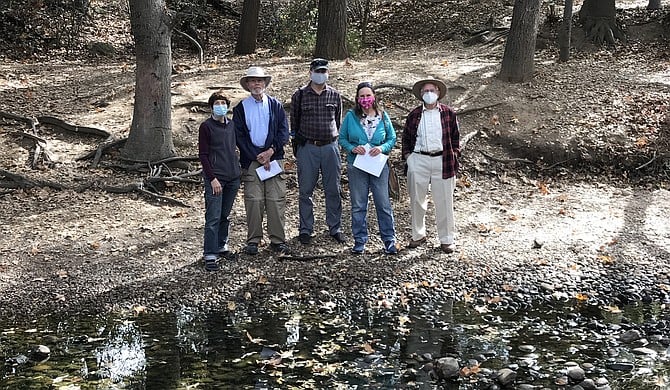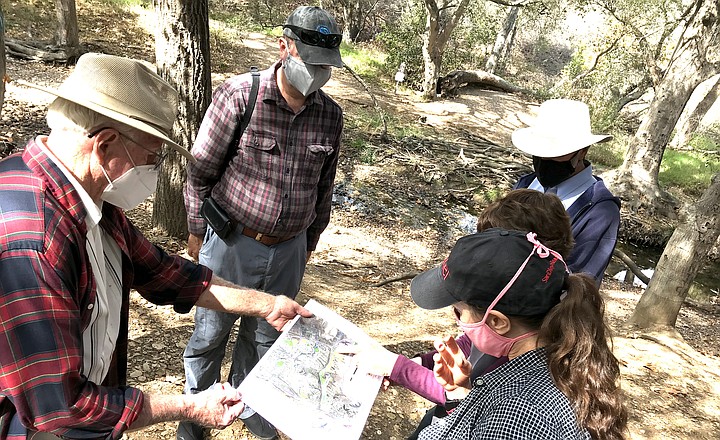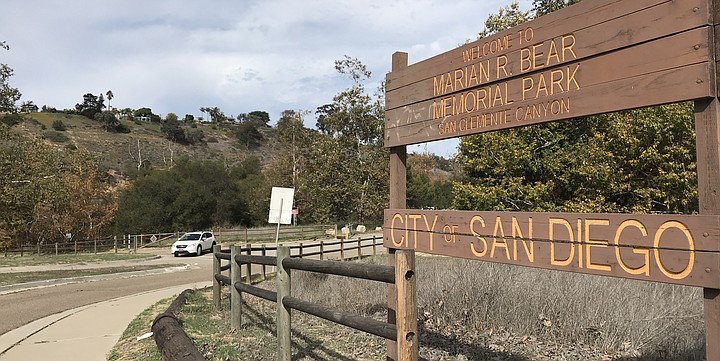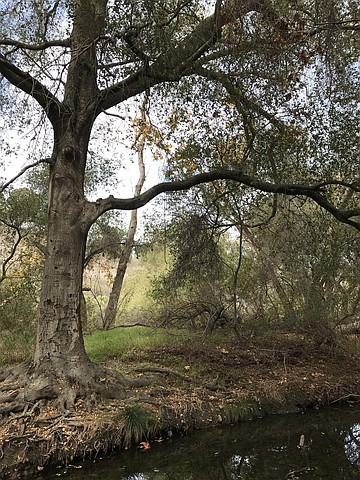 Facebook
Facebook
 X
X
 Instagram
Instagram
 TikTok
TikTok
 Youtube
Youtube

Occupying San Clemente Canyon alongside Highway 52 between I-5 and 805, Marian Bear Memorial Park is a small slice of riparian oasis in an urban landscape. Except for freeway noise, it’s easy to forget we’re in the city. A canopy of large old sycamores provides shade. San Clemente Creek trickles quietly. Then a truck rumbles by to remind us we’re close to the road, on a relatively narrow strip of green space, wedged between University City and Clairemont Mesa.
For several decades the freeway and the park have coexisted here, representing a commitment by city planners to protect San Clemente Canyon as a vital part of the Rose Creek watershed. Now Sandag is proposing to add more lanes of traffic to SR 52 where it runs alongside the park. But the plan isn’t final yet, and some locals want Mayor Todd Gloria to use his Sandag board vote to oppose it. Almost 4,000 people have signed a petition to “Save Marian Bear Park.”

The draft for the 2021 Regional Plan, which guides growth until 2050, includes adding three managed lanes to 52 between 5 and 805, and all the way east to 15, to encourage carpooling. Additional transit connector lanes to 5 and 805 would carry new Rapid buses 870 and 890, which might be filled with commuters opting out of personal vehicles.
“The goal is to provide a compelling option to driving, while maximizing current infrastructure,” said Coleen Clementson of Sandag. For the part of 52 that parallels the park, “There is no intention to go beyond the existing footprint [of SR 52].” Computer modeling with all the inputs from projected transit projects in the 2050 plan shows a greenhouse gas reduction of 20.4 percent per person, said Clementson, slightly better than the state-mandated target of 19 percent below 2005 levels.

“But even within the existing footprint, it’s still three more lanes of pollution, more runoff, more traffic,” said Deborah Knight, Friends of Rose Canyon director, who works to preserve green spaces and habitat. More noise will discourage migratory birds and wildlife from using the vital canyon corridor, more runoff will further degrade the quality of the water that flows from there into Mission Bay.
Gathered on the bank of San Clemente Creek on an overcast Monday afternoon, it’s a who’s who of environmental organizations: Audubon Society, Marian Bear Recreation Council, California Native Plant Society, and Friends of Rose Creek. They mobilized when they learned about Sandag’s plan, circulating a petition. One signer commented, “Why are we investing in more infrastructure for cars?!?! Expanding our freeways at the expense of our remaining open spaces is not the answer to traffic that San Diego needs.”

Elementary school students from Whitman and Hawthorne can walk to the park on field trips—descending through adjacent canyons to reach the stream and put their hands in the water. At night, deer, bobcats, mountain lions, coyotes, and a whole cast of nocturnal characters traverse the canyon. Jim Peugh of San Diego Audubon Society pointed out that the park provides a crucial wildlife connection to open space at Miramar—and local jurisdictions are obligated by the Multiple Species Conservation Program to comply with laws that protect large, connected habitat preserves.
Clementson said reconfiguring the 52 could result in improved wildlife corridors and further preservation of habitat, like the I-5 improvement project in Carlsbad that included restoring wetlands. But before any ground breaks on the 52 improvement project, Clementson said, an environmental impact report would be conducted. Details will be worked out in the future, after 2035 and before 2050.
“Come 2045, much of the plan will be built out. And our urban population will be far denser and Marian Bear Park’s open space even more valuable for both people and wildlife. It will then fall to San Diego’s future mayor and other elected officials to assess: do we need these three additional highway lanes badly enough ... and is building them worth the damage to Marian Bear Park?” Knight said.
“The city says it’s committed to CO2 reduction. It’s hard to say how adding three lanes of traffic reduces greenhouse gas emissions,” said Frank Landis of California Native Plant Society.
This is not the first fight San Diegans have put up for San Clemente Canyon. The park itself wouldn’t exist if not for the efforts of activist Marian Bear, a Clairemont Mesa resident who in the 1970s succeeded in having the 52 moved from the canyon floor to the hillsides above it, to preserve the creek.
“So the city has a tradition of protecting this park,” Knight said. She wants San Diego Mayor Todd Gloria, San Diego County Supervisor Terra Lawson-Remer, and San Diego City Council President Jennifer Campbell — all on Sandag’s board of directors — to simply delete from the regional plan the three additional lanes of traffic on the 52 between I-5 and I-805 before they vote on the plan in December.
“They can’t say they don’t know about it,” Knight said. “It will be on their watch if it goes in the plan.”


Occupying San Clemente Canyon alongside Highway 52 between I-5 and 805, Marian Bear Memorial Park is a small slice of riparian oasis in an urban landscape. Except for freeway noise, it’s easy to forget we’re in the city. A canopy of large old sycamores provides shade. San Clemente Creek trickles quietly. Then a truck rumbles by to remind us we’re close to the road, on a relatively narrow strip of green space, wedged between University City and Clairemont Mesa.
For several decades the freeway and the park have coexisted here, representing a commitment by city planners to protect San Clemente Canyon as a vital part of the Rose Creek watershed. Now Sandag is proposing to add more lanes of traffic to SR 52 where it runs alongside the park. But the plan isn’t final yet, and some locals want Mayor Todd Gloria to use his Sandag board vote to oppose it. Almost 4,000 people have signed a petition to “Save Marian Bear Park.”

The draft for the 2021 Regional Plan, which guides growth until 2050, includes adding three managed lanes to 52 between 5 and 805, and all the way east to 15, to encourage carpooling. Additional transit connector lanes to 5 and 805 would carry new Rapid buses 870 and 890, which might be filled with commuters opting out of personal vehicles.
“The goal is to provide a compelling option to driving, while maximizing current infrastructure,” said Coleen Clementson of Sandag. For the part of 52 that parallels the park, “There is no intention to go beyond the existing footprint [of SR 52].” Computer modeling with all the inputs from projected transit projects in the 2050 plan shows a greenhouse gas reduction of 20.4 percent per person, said Clementson, slightly better than the state-mandated target of 19 percent below 2005 levels.

“But even within the existing footprint, it’s still three more lanes of pollution, more runoff, more traffic,” said Deborah Knight, Friends of Rose Canyon director, who works to preserve green spaces and habitat. More noise will discourage migratory birds and wildlife from using the vital canyon corridor, more runoff will further degrade the quality of the water that flows from there into Mission Bay.
Gathered on the bank of San Clemente Creek on an overcast Monday afternoon, it’s a who’s who of environmental organizations: Audubon Society, Marian Bear Recreation Council, California Native Plant Society, and Friends of Rose Creek. They mobilized when they learned about Sandag’s plan, circulating a petition. One signer commented, “Why are we investing in more infrastructure for cars?!?! Expanding our freeways at the expense of our remaining open spaces is not the answer to traffic that San Diego needs.”

Elementary school students from Whitman and Hawthorne can walk to the park on field trips—descending through adjacent canyons to reach the stream and put their hands in the water. At night, deer, bobcats, mountain lions, coyotes, and a whole cast of nocturnal characters traverse the canyon. Jim Peugh of San Diego Audubon Society pointed out that the park provides a crucial wildlife connection to open space at Miramar—and local jurisdictions are obligated by the Multiple Species Conservation Program to comply with laws that protect large, connected habitat preserves.
Clementson said reconfiguring the 52 could result in improved wildlife corridors and further preservation of habitat, like the I-5 improvement project in Carlsbad that included restoring wetlands. But before any ground breaks on the 52 improvement project, Clementson said, an environmental impact report would be conducted. Details will be worked out in the future, after 2035 and before 2050.
“Come 2045, much of the plan will be built out. And our urban population will be far denser and Marian Bear Park’s open space even more valuable for both people and wildlife. It will then fall to San Diego’s future mayor and other elected officials to assess: do we need these three additional highway lanes badly enough ... and is building them worth the damage to Marian Bear Park?” Knight said.
“The city says it’s committed to CO2 reduction. It’s hard to say how adding three lanes of traffic reduces greenhouse gas emissions,” said Frank Landis of California Native Plant Society.
This is not the first fight San Diegans have put up for San Clemente Canyon. The park itself wouldn’t exist if not for the efforts of activist Marian Bear, a Clairemont Mesa resident who in the 1970s succeeded in having the 52 moved from the canyon floor to the hillsides above it, to preserve the creek.
“So the city has a tradition of protecting this park,” Knight said. She wants San Diego Mayor Todd Gloria, San Diego County Supervisor Terra Lawson-Remer, and San Diego City Council President Jennifer Campbell — all on Sandag’s board of directors — to simply delete from the regional plan the three additional lanes of traffic on the 52 between I-5 and I-805 before they vote on the plan in December.
“They can’t say they don’t know about it,” Knight said. “It will be on their watch if it goes in the plan.”
Comments